Back in August 2007, I attended an exhibition entitled "Asmara, Africa's Secret Modernist City" at the wonderful Bauhaus Centre in Tel Aviv. Being a fan of both modernist and art deco architecture, this was a real treat. The fantastic images in the exhibition and the accompanying publication made me want to get on the next plane to Asmara to see it for myself. Unfortunately, the cost of flights was prohibitive at that time and I had to wait until late 2010 when I was able to see not only Asmara but also Keren and Massawa, the other major cities in Eritrea.
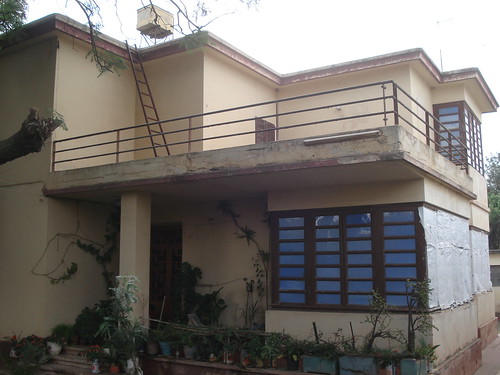 |
| Modernist villa in Asmara |
Asmara has a wonderful collection of about 400 modernist and art deco buildings dating from the 1920s and 1930s, part of the legacy of the colonial period when Eritrea, then part of Ethiopia was under Italian rule. The Italians believed they would be there for hundreds of years and so their architects, and of course, African labour, filled Asmara with beautiful modernist villas, shops, cafes and cinemas, many of which and many which still survive, although some have fallen into disrepair. This is hardly surprising given that the Eritreans fought for thirty years to gain their independence from Ethiopia, finally achieving this in 1993.
Like many capital cities around the world, Asmara boasts some impressive government buildings. Two that particularly stand out are the Municipality and the Ministry of Education both on Harnett Avenue. The Municipality is one of my favourite buildings in Asmara. Built from 1951-1971 in a simplified art deco style it stands out due to a central green tower with its clock and crowning disc displaying the symbol of Eritrea - the camel. The central tower also has a balcony for addressing the public and elongated windows on each wing. The green facade is made from mosaic tiles whilst the window frames are marble. Amazingly the architect is unknown, but what is known is that the state assembly hall in the rear of the building was inaugurated by our own Queen Elizabeth in 1965 during the Ethiopian period.
Further along Harnett Avenue, the Ministry of Education building dates from 1928 with an extension from 1940. Only the architects for the extension is known - Bruno Sclafani - more of whom later. Somewhat austere externally, this pink painted building was once home to a stunning set of paintings in the local style including depictions of the Queen of Sheba and King Solomon, the serpent of Eritrean and Ethiopian legend that is said to have shaped the land, other local fauna, St. George and the Dragon and several allegorical figures. Sadly this has all been destroyed in the period following independence. I was able to have a quick look inside this building - although not to take photographs. The main staircase retains echoes of a former grandeur with a decorative metal bannister which carries fascist symbols. The interior is painted in green and yellows.
 |
| Municipality, Harnett Avenue |
 |
| Ministry of Education, Harnett Avenue |
A stroll through Asmara in the late afternoon and early evening is perhaps the time to see it at its most interesting. The main thoroughfare - Harnett Avenue is the venue for the evening passagiata of hundreds of young Eritreans, dressed in their best clothes, promenading or talking in small groups. Many people will smile and say hello, buona sera or good evening to European visitors they pass in the street.
The Italian penchant for cafe culture - strong coffee and sweet pastries and patisserie - lives on amongst the Eritreans, as does a taste for good pasta and pizza. The many cafes fill up in the late afternoon and stay full until almost 10pm, when most people go home - this is not a party town. Royal Bar was my favourite serving great ice cream as well as the ubiquitous coffee and cakes. The customers are mainly groups of local young people, who come to drink, talk and look.
Many of the most ornate of the cafes are located within cinemas, including the wonderful Cinema Roma on Semtat Avenue. The cinema was originally to be called Cinema Dux but was refused planning permission because the name was judged to be too close to the title Il Duce (Mussolini). Building work started in 1937, originally under the direction of Italian architect Roberto Capellano and then Bruno Sclafani and it began life as the Excelsior. The interior was restored in the 1990's and features a selection of reds, ochres and oranges inside and out with marble on the exterior. For a few nakfa (the local currency), you can have a peak inside the auditorium outside of screening times. An enormous old projector is displayed in the lobby, surrounded by old Hollywood posters and many ardent smokers and serious coffee drinkers.
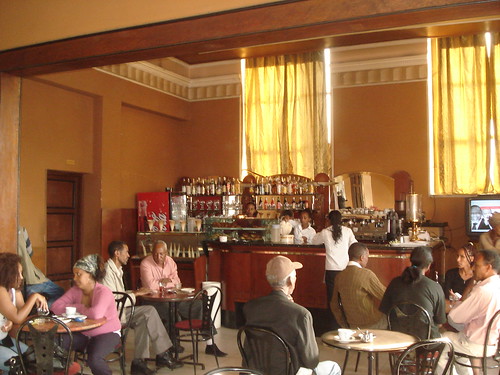 |
| Cafe in Cinema Roma, Semtat Avenue |
Another real landmark and further down Semtat Avenue is the stunning Fiat Tagliero Service Station. It's hard to believe that this beautiful building was a petrol station. It resembles an aircraft with massive, unsupported wings. Legend has it that the municipal authorities demanded that there be pillars to support the wings before granting permission to build and that the architect Guiseppe Pettazzi complied by using wooden pillars. At the building's unveiling he held a pistol to the head of the building contractor and ordered him to remove the supports. True or not, the original plans for the building, rediscovered in 2001 showed 30 poles propping up the wings. They are not there now! Restored in 2003, the building now belongs to the Royal Dutch Oil Company. It benefits from the highest level of protection in terms of listed building status meaning no changes can be made to the original.
Another wonderful deco style industrial building is the former silicon factory originally known as Agencia Lancia on Tegadelti Street designed by Carlo Marchi and Carlo Montalbetti and built in 1938. Built for wealthy Italian Santo Falletta it housed a service station, workshops, showroom and car exchange for the Lancia car company. Beautifully symmetrical with trademark deco portholes it has retained its wonderful projecting glazed central tower that once housed a water tank and was illuminated at night. In good condition at the time of my visit, the building is now all but hidden from the street by a wall and is easy to miss. Its definitely worth searching out and taking a peek.
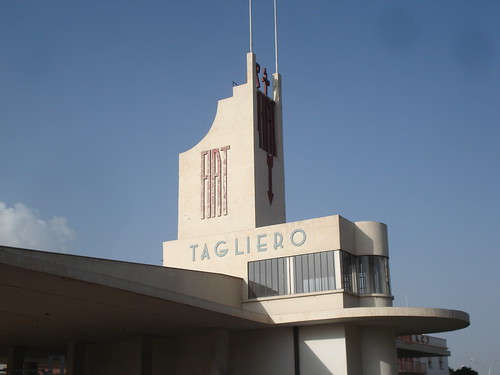 |
| The Fiat Tagliero service station, Semtat Avenue |
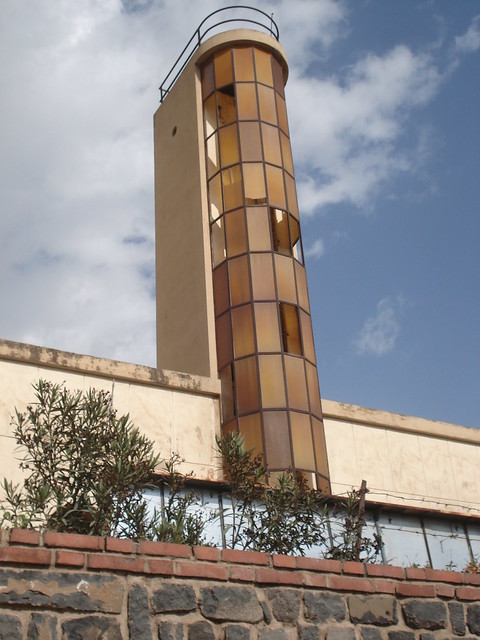 |
| Agencia Lancia, tower of former silicon factory, Tegadelti Street |
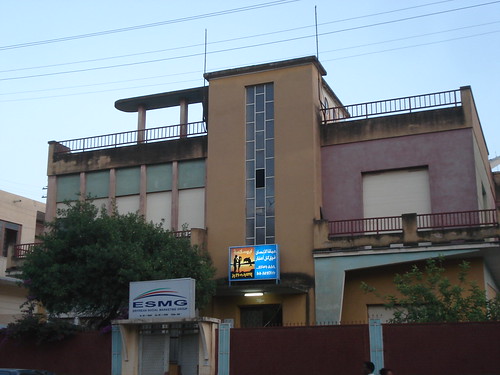 |
| Apartment building in Asmara - the caption on the front promotes family planning. |
Eritreans have learned to be extremely resourceful, through many years of war and a number of economic difficulties. Nowhere is this better illustrated than at the recycling market called "Medaber" - not to be confused with the Hebrew word medaber מדבר, meaning speak. Here you can see all kinds of materials - plastic, old oil drums, pieces of cloth - being used to create new and useful things. I especially liked the set of suitcases constructed from cardboard and cloth and the recycling of old tyres for water carriers. During the struggle for independence the Eritreans had a saying that "everything has its use and then another use". This is very clearly demonstrated at Medaber which provides employment to many local people.
The recycle market was just one example of the hard work on constant view in Eritrea as people strive to improve their lives and the position of their families and despite the difficulties faced by many people, the Eritreans I met were unfailingly helpful, friendly and generous. This included extending invitations to dinner in their home and even learning how to cook an omelette for me. You can read more about that here.
 |
| Young worker at the Medaber recycle market |
 |
| "Everything has its use and then another use" |
FANTASTIC - BEAUTIFUL PICTURES OF OUR ASMARA.
ReplyDeleteTHANK YOU ADRIAN,
Sami Cohen
Thanks very much Sami - I have very happy memories of my visit to Eritrea, especially Asmara.
DeleteYou took so wonderful pictures of my beautiful home city, Adrian! Thank you! PS: Eritrea was not a part of Ethiopia before the Italians..... You think you can fix that in your first paragraph... It infuriates Eritreans and disinformes the foreigners :)....Check Wikipedia for security.
ReplyDeleteI agree that Eritrea and Tigray shared the Axumite kingdom. Axumite itseslf is techinically and realistically not Ethiopia as we know it - Tigrayans themselves do not feel Ethiopian nor Eritrean, they feel only Tigrayans >> which is the greatest Ethiopian problem - because they at heart hate Ethiopia and Ethiopians (specially the amharas!!!) which is the reason for their genocide as now finally a ruling class https://www.youtube.com/watch?v=ikVl6auH83w....
Prior to Axum Eritrea was called the land of Punt https://www.youtube.com/watch?v=_uAJv4XXk2w, then we shared D'mt with northern Tigray as a different ethnic people and it developed to Axumite kingdom. We got separated for good since the fall of Axum in Eritrea in 600 AD after Persian defeat and a major flood that basically removed the ruling families and many eritreans as witnessed in the archeological work of Adulis, and Qohaito in ER. Very little is written about our version of Axumite kingdom with our kings.... but there are archeologists digging in ER and at least this gives a slight insight of the flood truth http://www.academia.edu/12432844/Geomorphological_mapping_and_palaeo-environmental_evolution_of_Adulis_harbour_Eritrea_Red_Sea_ (http://www.archeologiaviva.tv/ondemand/missione-adulis-la-ricerca-continua it's possible to follow them if you speak italian specially or just for pics - it's the first time any archeological site is filmed while on the process). The Persian Yemeni tale is available in any book. Arabs never did Jihad on us. Yemen wanted Persian help to kick out Axumites from arabia, while Persia wanted more power. http://www.amazon.com/The-Throne-Adulis-Emblems-Antiquity/dp/0199739323 (probabaly the best book that only talks about the war)
Okay, since the sea got under the control over the arabs, when they fast kicked out the Persians, we got colonised by the Beja people from southern Egypt when Egypt got colonised by the arabs in 700 AD (Peter Schmidt and co). In the 1100s, we started our own democratic state called Medri Bahri with the capital in Dubarwa https://en.wikipedia.org/wiki/Medri_Bahri ... The old bloodlines were extinct, so people voted their kings based on law. This kingdom continued even when the Turks took hold of the coastal land for 300 years and made zillion attempts for more land .... until ceasefire and even when the Medri Bahrians suffered constant Tigray war from the South at the same time. The modern border to Tigray was there from before, Mereb melash - a river... so even the map is it's not an Italian invention.... we have been lucky. Because both in Africa and Mid-east, there is this map problem that creates a mess between the people inside, and with their nabours. The tigray-ethio regime's border claime on ER is both unhistorical, unreasonable and illegal... it's just Tigray being Tigray as usual and they KNOW it... This hate and distrust have existed btwn Tigray and Eritrans since at least 2000 years, secondary source. Why else do we have only peace and love with our own differemt ethnic groups? :) Remember the others were also christians in their current ethnic groups before they converted to Islam..... the Italians just took over the country that was as it was. Actually, Eritreans helped the Italians in to kick out the muslim mehadist Egyptians and word off anoying Tigrayans from the South.
So, we were never Ethiopians, let alone Tigrayans.... It was rather always friendly with Sudan since almost they Egyptian era. The amharas and the rest of Ethiopia we never knew them......... we have night and day inconnectable mentality cultural differences (good or bad).....we learned to know them first time when we got forcibly tossed to be a part of Ethiopia by the UN to fit foreign interests in 1950, against our will... that's the only time we have been Ethiopian.
ReplyDeleteThe amhara people are probably runaways from the Persian raid and the big flood in 600 AD from Eritrea (at least some of them) but possibly mostly Tigray people who at some time went further south and married with agaw people ((or they may have come through the nile??)) which today is the reason Amharic linguistically is 75% south cushetic and 25% semetic. You can spot an even from afar, but only clothing and dialects differentiate the Tigrayans from us the (bihere tigrigna of ER). Btw, the bihere tigrigna were never called hamasien before.... hamasien is just a region - only the Tigrayans calls us that to dismantle Eritrea. https://en.wikipedia.org/wiki/Hamasien. The capital of egyptian era ER might have been Hamasien, since it's rich of puntite archeology and it is mentioned several times by the Egyptian courts as a place they visited formely.... Otherwise exist at least in 3 regions since the fall of Axum and coastal occupations; hamasien, akale guzay and serae. And before that, we lived by the sea too. Why do you think the ruins at Adulis remained uninhabited?? Because people runned away and spread. Adulis was super important port city since ca 4000 years ago. To make bad analogy, it was like New York to DC in the Axumite or Puntite era.
So, please remove or edit your first paragraph. It's hurtful and incorrect... You know we have a lot of problems and why we have those problems. People not knowing our history and who we are is also a major problem. The manipulation of our history to the international world has been there ever since the amharas took the power in central Ethiopia (not even in Tigray) in the 1200s under the Yekuno Amlak (who falsely claimed Solomic blood linehttps://en.wikipedia.org/wiki/Damot), and King Yohannes who stole the name Ethiopia from Sudan https://en.wikipedia.org/wiki/Yohannes_IV - claimed themselves the Christian saints to the Portigues and wrote litters to queen Victoria. Not, even the Tigrayans claimed these pack of lies!!
These lies is the reason we suffer, combined with American and western illadvised imperiliastic interests. People can't see pass these humbugs, and it basically super annoys us!
To say it bluntly, it was rather our own history and identity that got hijacked by people who had nothing to do with it. Even the script geez is Eritrean from 900 BC in Akele Guza region. They shouldn't actually call geez Ethiopic or ethio-semetic, it is in fact Geez from Eritrea, or agazi. And the history of Ethiopia in the bible is the history of Nubia, and the queen of sheba is Yemeni (The Yekuno Amlak lie - the guy who created the abesynian kingdom in amhara, exlcuding Medri Bahri)! For this reason, you will rarely hear Eritrean call himself an habesha.... The original habesh btw are Yemeni tribe that use to live off the frankinsece trade and that now are extinct....again it's only the Ethios (amhara in particular) that use the term habesh to themselvs probaly connected to their kings lie of queen of saba and king Solomon! The Amharas still claime Yemen as their colony state, when they in fact had nothing to do with Yemen. http://www.madote.com/2013/01/the-true-origin-of-habesha.html
ReplyDeletehttp://www.ajol.info/index.php/afrrev/article/viewFile/43592/27115 (queen of sheba-lie)
The geez speakers of all Eritrean creeds were for this reason called agazeen as appose to Tigray and beyond tigray agaws.... Agazeen was a nationality collecting term for us all specially as oppose to Tigrayans as a whole. But it's more than that..... almost all Eritreans - share common hametic ancestor that are called north hametic - these people that looked somewhat like modern day bejas - came from southern Egypt during the Punt time 4000 years ago..... And the semites that came also during the Punt time (3000-3500 years ago through Egypt or directly from the Levant (not Yemen) ) - they mixed in with the existing agazeens of Punt and the agaws of Tigray. Hence the hate began probably (almost certain) for this reason at least 2000 years ago, chocking to me!!...... Punt didn't include Tigray at all at the time, but it included eastern Sudan. They did a geological DNA test, and it was neither Tigray, Yemen or Ethiopia. But, possibly Tigray was a some kind of colony from time to time. So probably for this reason the Tigrays remember us (biher -tigrinya) as Hamasien, the name of the place where Punt used to get state visits from their tightest ally Egypt and possibly Phoenicia too (for they certainly were in Adulis),- the possible capital of Punt - which accidently is at the heart of Asmara! Hamasien btw means the place of ham and sem. Hamasien not from the bible which can be a fairytale... but written about Punt in the walls of Egypt! Which further explains the reason scientits used more than 100 years to find Punt's where abouts... because sometimes they looked "negroids" exactly like the Nubians (nilotic the kunama and nara people of Eritrea), most of the times they blooked brown reddish like the Egyptians (with the same hair styles and body similar to the bejas), and other times they looked blond with blue eyes like the Levantines. And the created confusion between Punt (Puen in ancient egyptian), and Phoenicia, which is not exactly an accident!
conitnuation..... of third comment:
ReplyDeleteYes, intermarriage with Tigray and Eris has happend.... but looking back in history and the strong sentiments of distrust and lack of relaxed love that we have till today, I seriously doubt there was anything on grand scale.
Even during axumite era that included Tigray and that had Tigryan Axum as a capital (in reality most of Axmite, areal and cities, is in Eritrea and is said to have started in there as a result of amalagamation of the growing market within the internal regions), but the capital was theirs so was their second city (Yeha) on their border with ER). So, the relations to each other witness the same distrust and meanness. The Axumite relation is notorous for this!
We have agaw descendents (south cushetic/hametic) in ER that came from Tigray or beyond in the 1400s due to some kind of persecution. And we love our agaw Bilens like we love all our agazeen brothers!
The problem is just that the Tigrayans, the people of semetic and agaws interbred, are mean and jealous of Eritreans since forever. The action was always in Eritrea and we were arrogant towards them eions before the Italian industrulization of ER that made them our maids. Their inferiority sentiments and meanness have always been there. And we always thought we were better, though their axum city, good looks, hard working and good money-sense personality was always acknowledged by us. We just feel the hate, because if we trust them and show loyality, they will destroy us with no mercy..... like the presiden was worned by our elders; never do trust these creeds esais", if he had listened to them... things will have been different for Eritrea today!
Sorry, I got a bit carried away in this last third and this last thread...... I'm at a hotel and bored...luckly my opinions are for the most part based on facts and it's not bullshit, lol :).
Thank you for these beautiful pictures of yours and for visiting Eritrea, we, at least I appreciate that a lot! :) And I know most Eritreans do! Best wishes and best of luck in your life! Ciao